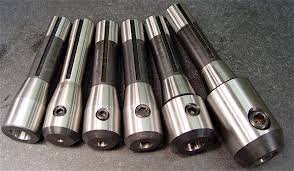OK I see and have used these (mostly for endmills that are bigger than a set of collets that go up to 3/4")...I see R8's for maybe a Bridgeport?...Still many questions and why's here but generally (and I see "perfect" in the title)....indicate the part stock or R8 (or whatever) blank) (prehard tool steel) dead on...turn, drill (undersize about 1/64 or whatever)...check and indicate again and then bore to size with a great finish (hopefully at least a 4 to 6 rms or better)...(using whatever ID gauge or instrument yoose' gots' to measure while "sneaking up" while boring)...use a 1/4" endmill itself for the final "go" gauge (you'll end up at about .0002 or .0003 over the endmill body dia. (and watch and make sure part is cooled down ("normalized") before the final passes...
...or, as said somewhere above and if your lathe? or mill? is somewhat "out": Do the above but bore to .248 to .249...then dull up the leading end cutting edges of a .250 reamer and run it through straight (hopefully not much if any runout)... and again use an endmill itself for fit...if it doesn't fit run the reamer through in and out until that endmill goes...(dulling up the leading "end" edge of a fin. size reamer is a key here to not going oversize in tenths...along with straight and rpm (slow!) and cutting fluid of course)
...or best is do the above boring but use unhardened tool steel and you bore leaving about .005 or whatever but you need a oxy/acytelene torch and a universal or toolpost grinder to grind the hardened and tempered (by colors (eyeball) rc55 -60) part hole to size (fit)...(and at least abraisive "paper" (if no bead blaster) to give (turn/spin) the part some TLC after torch/hand HT...
Note: Making this or similar use holders/parts should be made out of at least a prehard steel (or cast iron is OK but dirty LOL)

